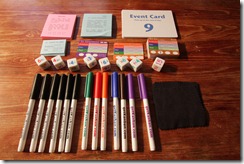Version 3 of the getKanban board game has finally arrived. It is now over a year ago since I saw a prototype of version 3 at Lean Software & Systems Conference 2011 and I have been waiting for it’s arrival ever since.
Guess the excitement when the delivery truck pull up this week!
We immediately had to unpack the package and see how the final version looked like.
The game comes in a practical and nice looking bag.
When you open the bag you will find:
- One green sleeve containing the game board and the four erasable charts
- One clear tote bag containing the story cards, the custom dies, all the different colored pens and some custom sticky notes
- One cotton bag containing the expedite stories and the outcome cards
So lets set it up!
This is the recommended setup as described in the new and much improved facilitators guide. The new facilitators guide is now delivered as two separate slide decks. One for the Quick Play mode, and on for the Standard and Advanced mode.
When you setup the game you will find that the overall quality of the game is much higher compared to version 2. The game board has a plastic surface that you can write on and then clean. This is a great as the version 2 game board starts to look quite messy after a few games.
All the new cards are also of higher quality and are now made of some plastic material. This applies to the charts as well. They are now made in a much thicker plastic material that is much easier to clean.
The gameplay
There are so many improvements to the game and the gameplay. I will only point to a few of them here. I will leave it up to you to discover the rest when you get your own copy or you have me or one of my colleagues from Avega Group over for some gameplay ![]()
The game now has three different play modes:
- Quick Play – Designed to be played in 60 – 90 minutes. Only one chart is tracked, WIP limits may not be adjusted and many learning points are skipped over.
- Standard – Designed to be played in 2,5 – 3 hours. All of the charts are tracked, cycle time is collected, WIP limits may be adjusted and the concept of class of service is introduced.
- Advanced – Designed to be played for a minimum of 3 hours. More advanced concepts are introduced, and winning and losing strategies make themselves much more evident in the final stages of the game. There are more opportunities to analyze and discuss the impact of events, and other aspects of the game.
The most visible change in version 3 is the custom dies. The new dies have three numbers in different colors on every side. The different colors represents the different specialties. Red for the analysts, blue for the developers and green for the testers. When you play a die in a column you use the number with the corresponding color. If you play the die according to its specialty you will get higher numbers. The dies no longer span between 1 and 6. The large numbers are between 3 and 6 and the smaller are between 0-3. This will reduce the variability and luck will have a smaller impact on the game outcome.
One other big difference is the introduction of replenishment and deployment cadence. In version 3 you can only replenish your input queue and deploy your stories at the end of the three day billing cycle. I think this is great as this mimics reality better. And just as in reality these process policies can be changes in the game.
The forth change I want to point out is the ability to change the work-in-process limits. As this is a core part of Kanban it is great that it is now part of the game. I have for some time allowed this when playing the version 2 as described in a previous post.
Playing the game
I have played the prototype version once. I have also facilitated a preproduction version as part of the Accredited Kanban training we ran at Avega Group earlier this year.
Version 3 of the getKanban game is a big step forward compared to the previous versions. Much more learning opportunities and also more opportunities to improve on the process, which is the main point of the Kanban Method.
I highly recommend the new and improved version 3 of the getKanban game.
Thank you Russell Healy for a great game!
I also want to say thank you to Russell Healy at getKanban Limited and Daniel Vacanti at Corporate Kanban for the copies of the game I have received.




































